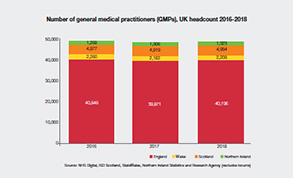NHS in numbers: general practice
General practice has a problem. It doesn’t have enough people to do the work required. A five-year framework for the GP services contract, published just after the NHS long-term plan, acknowledged this. And it sets out plans to address the issue by increasing GP numbers but also increasing the wider primary care workforce to reduce GP workload.
The General practice forward view in 2016 promised to create an extra 5,000 doctors in general practice by 2020 (compared with 2014). However, January’s NHS long-term plan acknowledged that any increase in new recruits had been more than offset by the number of early retirements and part-time working.
It recommitted to a net increase of 5,000 GPs, but this time it left the deadline more vague – ‘as soon as possible’.
According to figures from the Review Body on Doctors’ and Dentists’ Remuneration (DDRB), in September 2018 there were 48,721 GPs in the UK (headcount) – with England accounting for 40,196 of these. This includes all regular GPs, but excludes locums. There were small increases compared with the previous year in all the UK countries, however in both England and Wales, the numbers were lower than in 2016.
The latest figures from NHS Digital for England in June show that if you include locums, the headcount number rises to 44,570, which equates to the arguably more informative figure of 34,114 full-time equivalent GPs.
This demonstrates the extent of part-time working in general practice. GP registrars (GPs in training) make up nearly 6,000 of the overall headcount figure.
The NHS Digital data demonstrates that this summer’s full- time equivalent figure is actually lower than in September 2015 (34,262). (An apparent increase in headcount over this same period is explained by changes in how locum figures were collected.)
Between them, these GPs provided 309 million appointments in the 12 months from the beginning of August 2018. In July, there were 27 million appointments (although this figure covers various health professionals working in general practice.
The vast majority continue to be delivered face-to-face.
However, there has been a 30% increase in telephone appointments (from three million a year ago to four million in July this year, and a 50% increase in online appointments (from 109,000 to 160,000).
This latter figure is being driven by the availability of services from organisations such as Babylon Health (GP at Hand) and Livi. And, according to the long-term plan, everybody should have the ability to access a GP digitally within five years.
In Scotland at the end of 2018, there were 4,994 GPs (headcount). While this was a small increase on the previous year, the figure had been roughly constant for the preceeding 10 years, at around 4,900. Earlier figures show this equated to 3,575 full-time equivalent GPs in 2017, a 4% decrease since 2013.
There are plans to increase GP headcount by 800 over the next 10 years, but Audit Scotland says that an ageing clinical workforce and problems with recruitment and retention will make this difficult to achieve.
In Wales last year, there were 2,986 GPs, counting all practitioners. In Northern Ireland, figures for last year (headcount) show there were 1,722 GPs excluding doctors in training, including 1,149 GP principals.
Related content
The Institute’s annual costing conference provides the NHS with the latest developments and guidance in NHS costing.
The value masterclass shares examples of organisations and systems that have pursued a value-driven approach and the results they have achieved.